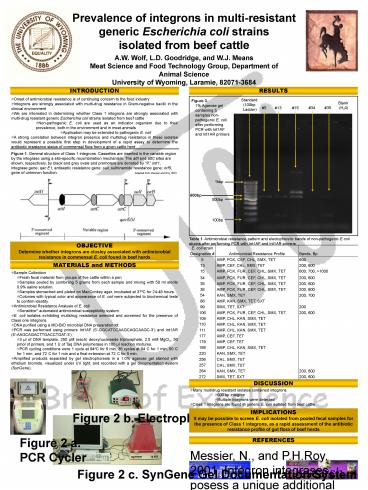A'W' Wolf, L'D' Goodridge, and W'J' Means - PowerPoint PPT Presentation
1 / 1
Title:
A'W' Wolf, L'D' Goodridge, and W'J' Means
Description:
AMP, FOX, FUR, CEF, CHL, SMX, TET. 15. AMP, CEF, CHL, SMX, TET. 13 ... are shown, respectively, by black and grey ovals and promoters are denoted by 'P. ... – PowerPoint PPT presentation
Number of Views:29
Avg rating:3.0/5.0
Title: A'W' Wolf, L'D' Goodridge, and W'J' Means
1
Prevalence of integrons in multi-resistant
generic Escherichia coli strains isolated from
beef cattle
A.W. Wolf, L.D. Goodridge, and W.J. Means Meat
Science and Food Technology Group, Department of
Animal Science University of Wyoming, Laramie,
82071-3684
INTRODUCTION
RESULTS
- Onset of antimicrobial resistance is of
continuing concern to the food industry - Integrons are strongly associated with multi-drug
resistance in Gram-negative bacilli in the
clinical environment - We are interested in determining whether Class 1
integrons are strongly associated with multi-drug
resistant generic Escherichia coli strains
isolated from beef cattle - Non-pathogenic E. coli are used as an indicator
organism due to their prevalence, both in the
environment and in meat animals - Application may be extended to pathogenic E. coli
- A strong correlation between integron presence
and multidrug resistance in these isolates would
represent a possible first step in development of
a rapid assay to determine the antibiotic
resistance status of commensal flora from a given
cattle herd
Figure 1. General structure of Class 1 integrons.
Cassettes are inserted in the variable region by
the integrase using a site-specific recombination
mechanism. The attI and attC sites are shown,
respectively, by black and grey ovals and
promoters are denoted by P. intI1, integrase
gene qac E1, antiseptic resistance gene sulI,
sulfonamide resistance gene orf5, gene of
unknown function.
Adapted from
Messier and Roy, 2001
Table 1. Antimicrobial resistance pattern and
electophoretic bands of non-pathogenic E.coli
strains after performing PCR with Int1AF and
Int1AR primers
OBJECTIVE Determine whether integrons are closley
associated with antimicrobial resistance in
commensal E. coli found in beef herds
MATERIALS and METHODS
- Sample Collection
- Fresh fecal material from groups of five cattle
within a pen - Samples pooled by combining 5 grams from each
sample and mixing with 50 ml sterile 0.9 saline
solution. - Samples stomached and plated on MacConkey agar,
incubated at 37oC for 24-48 hours. - Colonies with typical color and appearance of E.
coli were subjected to biochemical tests to
confirm identity. - Antimicrobial Resistance Analysis of E. coli
- Sensititre automated antimicrobial
susceptibility system. - E. coli isolates exhibiting multidrug resistance
selected and screened for the presence of Class
one integrons - DNA purified using a MO-BIO microbial DNA
preparation kit - PCR was performed using primers Int1AF
(5-GGCATCCAAGCAGCAAGC-3) and Int1AR
(5-AAGCAGACTTGACCTGAT-3) - 3 µl of DNA template, 250 µM (each)
deoxynucleoside triphosphate, 2.5 mM MgCl2, 50
pmol of primers, and 1 U of Taq DNA polymerase in
100 µl reaction mixtures. - PCR cycling conditions were 1 cycle at 94oC for 5
min, 35 cycles at 94C for 1 min, 50C for 1 min,
and 72C for 1 min and a final extension at 72C
for 5 min. - Amplified products separated by gel
electrophoresis in a 1.0 agarose gel stained
with ethidium bromide, visualized under UV light,
and recorded with a gel documentation system
(SynGene).
DISCUSSION
- Many multidrug resistant isolates contained
integrons - 600 bp integron
- Multiple integrons were detected
- Class 1 integrons are found in generic E. coli
isolated from beef cattle
IMPLICATIONS It may be possible to screen E. coli
isolated from pooled fecal samples for the
presence of Class 1 integrons, as a rapid
assessment of the antibiotic resistance profile
of gut flora of beef herds
Figure 2 b. Electrophoresis Apparatus
Figure 2 a. PCR Cycler
REFERENCES
Messier, N., and P.H.Roy. 2001. Integron
integrases posess a unique additional domain
necessary for activity. J. Bacteriology. 183
(22) 6699-6706.
Figure 2 c. SynGene Gel Documentation System

